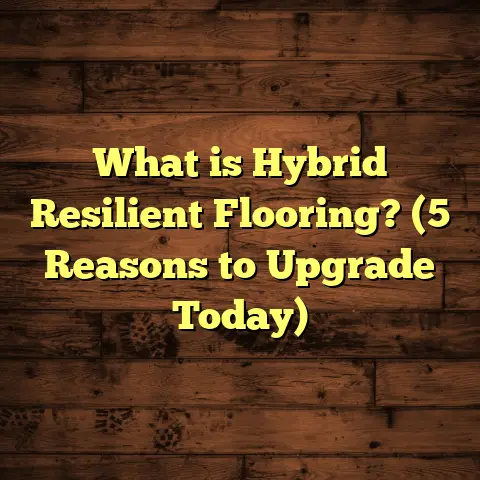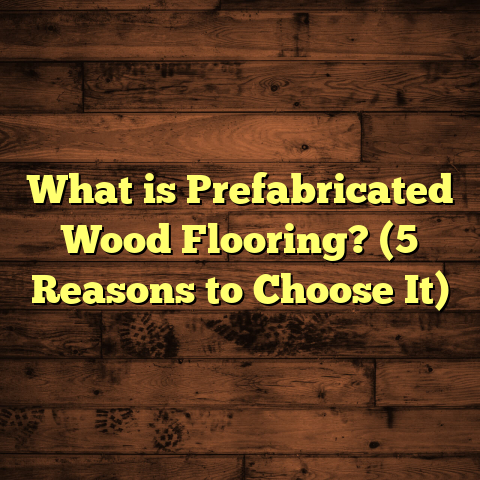What is Cheaper: Tile or Laminate Flooring? (5 Key Cost Factors)
I want to start by sharing a flooring tip that saved me and many clients a lot of money over the years: never just jump at material costs alone when choosing between tile and laminate. It’s tempting to pick what looks cheaper on the surface—like a $1 per sq ft laminate plank versus a $5 tile—but there’s a lot more under the hood that affects the total price of your project. Installation, durability, maintenance, and even how long you plan to keep the floor all influence the real cost. Over time, this approach has helped me advise homeowners smarter and avoid expensive surprises.
What is Cheaper: Tile or Laminate Flooring?
Let’s begin by clarifying what we’re talking about and why this question even comes up so often.
Tile and laminate are two of the most popular flooring choices for residential spaces. Both offer durability and style, but they come from very different worlds in terms of material makeup, installation methods, lifespan, and maintenance needs. Understanding these differences in detail is crucial before making a buying decision.
Tile Flooring: The Basics
Tile flooring usually refers to ceramic or porcelain tiles made from natural clay that’s baked at very high temperatures. These tiles are rigid, durable, and resistant to moisture. Ceramic tiles tend to be lighter and less dense, while porcelain tiles are denser and less porous, making them ideal for high-moisture areas like bathrooms and kitchens.
Tile surfaces can be glazed or unglazed and come in countless colors, patterns, and finishes—from matte stone looks to glossy modern styles. You can find tiles ranging from 4×4 inches up to large slabs measuring 24×24 inches or bigger. Thicker tiles generally cost more but last longer.
The price range for ceramic tile materials varies widely. In my experience working across different markets—from small towns in the Midwest U.S. to urban areas in Canada—I’ve seen ceramic tiles priced between $1 and $5 per square foot. Porcelain tiles often start at around $3 per square foot and can reach $7 or more for premium imported varieties.
Laminate Flooring: What’s Inside?
Laminate flooring is a synthetic product made of several layers fused together. The core is usually high-density fiberboard (HDF), topped by a photographic image layer that mimics natural wood or stone, and sealed with a durable clear coating.
Laminate is popular because it’s easy to install, often featuring click-lock planks that snap together without glue or nails. It’s also lighter than tile and warmer underfoot, making it comfortable in living rooms and bedrooms.
Prices for laminate vary depending on thickness, brand, and image quality. For decent quality laminate, you’re generally looking at around $1 to $3 per square foot. Higher-end laminates with realistic textures or enhanced scratch resistance can go up to $4 or $5 per square foot.
1. Material Costs: Comparing What You Pay at the Store
When I first started in flooring contracting about 15 years ago, I thought laminate was always the cheaper option because of its lower sticker price. But I quickly learned that material costs alone don’t tell the full story.
Take this example from a typical project in Milwaukee, Wisconsin:
- For a 200-square-foot kitchen renovation, the client was choosing between mid-range porcelain tile costing about $4 per sq ft and high-quality laminate priced at $2.50 per sq ft.
- Material cost for tile: 200 sq ft × $4 = $800
- Material cost for laminate: 200 sq ft × $2.50 = $500
At first glance, laminate clearly wins by $300 on materials alone.
But wait—there’s more.
In another case from Seattle, Washington, I saw ceramic tile priced as low as $1.75 per sq ft at a local supplier for basic white tiles. Meanwhile, laminate options started at $1 but cheap laminates tend to warp easily in moist Pacific Northwest homes.
Quality Affects Price Big Time
Cheap laminate flooring below $1/sq ft might seem tempting but usually has thinner wear layers and lower-density cores that won’t last more than 5 years in busy households.
On the other hand, premium porcelain tiles priced above $6/sq ft often come with better finishes that resist stains and scratches much longer.
So when budgeting for materials, I always tell clients to think about what quality level fits their lifestyle—not just the cheapest number.
2. Installation Costs: Labor Makes a Huge Difference
Material price is just one piece of the puzzle. Installation costs often surprise homeowners because they can double or triple your flooring budget depending on complexity.
Tile Installation
Tile installation is labor-intensive. It requires:
- Preparing a completely flat subfloor (which might need extra work)
- Laying down cement backer boards in some cases
- Applying mortar evenly
- Cutting tiles precisely to fit edges and corners
- Installing grout carefully between tiles
- Sealing grout afterward to prevent staining
I’ve installed tile floors ranging from simple square layouts to intricate herringbone patterns. The latter dramatically increase labor time—and your bill.
Installation costs for tile generally fall between $4 and $10 per sq ft, depending on:
- Geographic location (urban centers cost more)
- Complexity of pattern
- Tile size & type
- Subfloor condition
In Los Angeles, I’ve seen tile installation running as high as $9 per sq ft due to labor rates and permits required for some home renovations. In smaller towns like Des Moines, Iowa, it can be closer to $4-$5 per sq ft.
For our 200 sq ft kitchen:
- Tile installation cost: 200 × $7 (average) = $1,400
Laminate Installation
Laminate is much easier and quicker to install because the planks lock together without mortar or grout. Many homeowners even DIY laminate flooring because it doesn’t require specialized skills or tools.
If you hire a pro, expect around $2 to $5 per sq ft depending on region and room shape.
For 200 sq ft:
- Laminate installation: 200 × $3 (average) = $600
This difference adds up fast — saving you approximately $800 on labor alone by choosing laminate over tile in this scenario.
3. Long-Term Durability and Maintenance Costs
Here’s something I’ve learned from working with clients over years: the floor that looks cheapest upfront can become the most expensive if it needs frequent repairs or replacement.
Tile Longevity
Ceramic and porcelain tiles are among the most durable flooring options you can get. I’ve seen tiled kitchens in homes over 20 years old still looking great with minor grout touchups.
Tile resists scratches, stains, and water damage exceptionally well—making it ideal for busy families or places prone to spills like bathrooms or mudrooms.
Routine care involves sweeping or vacuuming regularly and mopping with mild cleaner. Every few years grout might need resealing—a task costing roughly $100-$300 depending on area size.
Over 10 years:
- Annual maintenance cost: Approx. $50-$100
- Lifespan: Easily 20+ years
Laminate Wear and Tear
Laminate floors have improved but still can be vulnerable to moisture damage if water sits on seams too long. Scratches can show after heavy use from pets or kids’ toys too.
Many budget laminates start showing wear within 5-7 years. Replacement becomes necessary after that period unless you opt for very high-end products with thicker wear layers (which cost more upfront).
Maintenance mainly involves dry cleaning methods—vacuuming/dusting regularly plus spot cleaning spills quickly. Avoid soaking floors or using abrasive cleaners.
Replacement cost (after ~7 years):
- $2-$4 per sq ft (material + installation)
For our 200 sq ft room:
- Potential replacement in 7 years = $400-$800 again
This means laminate could cost almost double over a decade compared to tile if you factor lifespan.
4. Waste Factor and Subfloor Preparation: Hidden Expenses
One of my earliest lessons as a contractor was that waste factor—the extra material needed due to cuts and breakage—is often overlooked by homeowners budgeting flooring projects.
Waste Factor
For tile installations:
- Waste factor is typically 10-15% because you must cut tiles around edges, corners, doorways, cabinets.
- Sometimes breakage during transport or installation adds to waste.
- For a 200 sq ft room with 15% waste, you need about 230 sq ft of tile.
If tile costs $4/sq ft:
- Material needed = 230 × $4 = $920
For laminate:
- Waste factor is lower—usually around 5-7% since planks interlock easily.
- So for 200 sq ft + 7% waste = 214 sq ft.
If laminate costs $2/sq ft:
- Material needed = 214 × $2 = $428
This difference adds up—especially on larger projects where waste can add hundreds of dollars unexpectedly if not planned properly.
Subfloor Preparation
Tile needs a perfectly flat and stable subfloor to avoid cracking later on.
If your existing floor isn’t level or is damaged:
- You may need self-leveling compounds ($1-$3 per sq ft)
- Or replace plywood underlayment ($2-$5 per sq ft)
This prep work can add several hundred dollars or more depending on your home’s condition.
Laminate tolerates minor imperfections better but still requires clean, dry surfaces free from debris or moisture.
5. Resale Value and Visual Appeal Impact
If you plan to sell your home within several years of installing new flooring, resale value becomes an important factor in your choice.
Tile Adds More Value
In my experience working alongside real estate agents, tile floors tend to impress buyers more than laminate—particularly in kitchens and bathrooms where water resistance matters most.
A recent study I reviewed showed homes with tiled kitchens sold for about 2–3% higher prices on average than similar homes with laminate floors in those rooms.
Laminate Can Look Good but Perceived as Cheaper
Laminate has come a long way with realistic wood-look designs but still often feels less luxurious compared to stone or ceramic tile when buyers walk through a house.
That said, laminate does have advantages:
- It’s warmer underfoot
- Easier to change out later if tastes shift
- Less expensive upfront if budget is tight
Personal Experience: Real Projects That Taught Me Lessons
Years ago I worked on two side-by-side renovation projects that taught me a lot about these choices.
Client A picked cheap laminate for their kitchen floor at around $1 per sq ft plus DIY installation. Within three years, water damage near the sink caused swelling and warping on several planks. The homeowner ended up paying over $3,000 to replace the entire floor professionally after trying quick fixes themselves first.
Client B spent about twice as much on mid-range porcelain tile including professional installation in their bathroom remodel five years ago; it still looks flawless despite heavy foot traffic and moisture exposure.
From those experiences—and dozens more—I saw how initial savings on laminate sometimes led to unexpected expenses down the line while tile held up well with minimal upkeep.
Using FloorTally Helps Me Plan Better Budgets
One tool that has made my life easier is FloorTally. It lets me input exact room dimensions, select materials with local pricing data, add labor rates specific to my region, factor in waste percentages, and get detailed cost breakdowns instantly.
I use it both for personal projects and client estimates because it helps avoid guesswork when comparing tile vs laminate options side by side based on real numbers instead of vague averages.
It’s not just about saving money—it also saves time by consolidating everything into one easy interface so I don’t have to request multiple quotes or manually calculate waste percentages every time.
Detailed Cost Breakdown Example: 400 Sq Ft Living Room
Let’s run through a bigger room example with current average prices from my region (Midwest U.S.):
| Cost Factor | Tile (Ceramic) | Laminate |
|---|---|---|
| Material Price | $3 per sq ft | $2 per sq ft |
| Material Needed | 460 sq ft (15% waste) | 428 sq ft (7% waste) |
| Material Cost | 460 × $3 = $1,380 | 428 × $2 = $856 |
| Installation Labor | $6 per sq ft | $3 per sq ft |
| Labor Cost | 400 × $6 = $2,400 | 400 × $3 = $1,200 |
| Subfloor Prep | Flat & sound floor assumed | Minor cleaning only |
| Maintenance/year | ~$75 | ~$150 (replacement reserve) |
| Typical Lifespan | 20+ years | 7–10 years |
Total initial cost estimate:
- Tile: $1,380 + $2,400 = $3,780
- Laminate: $856 + $1,200 = $2,056
If you spread out the cost over lifespan:
- Tile: ~$189/year ($3,780 ÷ 20)
- Laminate: ~$296/year ($2,056 initial + possible replacement every 7–10 years)
This shows tile’s upfront price is higher but pays off over time due to durability.
What About Environmental Impact?
Another angle I consider when choosing between tile and laminate is environmental footprint.
Tiles are made from natural materials—clay—and last decades without needing replacement often reducing waste sent to landfills.
Laminate uses synthetic resins and photographic layers which aren’t biodegradable. Plus replacing laminate multiple times creates more waste overall.
If eco-friendliness matters to you alongside price, tile often has an edge here too.
Summary of Key Points
| Factor | Tile | Laminate |
|---|---|---|
| Initial Material Cost | Moderate – Higher quality varies | Lower – But quality varies widely |
| Installation Cost | High – Skilled labor required | Low – DIY possible |
| Waste Factor | Higher (10-15%) | Lower (5-7%) |
| Maintenance | Low – Occasional grout sealing | Moderate – Replace sooner |
| Lifespan | Long (20+ years) | Short-medium (5–10 years) |
| Resale Value | Higher – Preferred by buyers | Lower – Perceived as cheaper |
| Environmental Impact | Natural materials | Synthetic materials |
If you’re trying to answer “Which flooring costs less?” I encourage you to think beyond just price tags on boxes. Consider how long you want your floor to last without headaches or extra spending. Think about your skill level if installing yourself. And remember that tools like FloorTally can help crunch numbers tailored exactly to your project size and location so you’re not left guessing what “average” really means where you live.
Want me to help run numbers for your specific space? Just let me know your room dimensions and budget constraints!
I hope these insights help make your flooring decision clearer—and save you money in the process!





